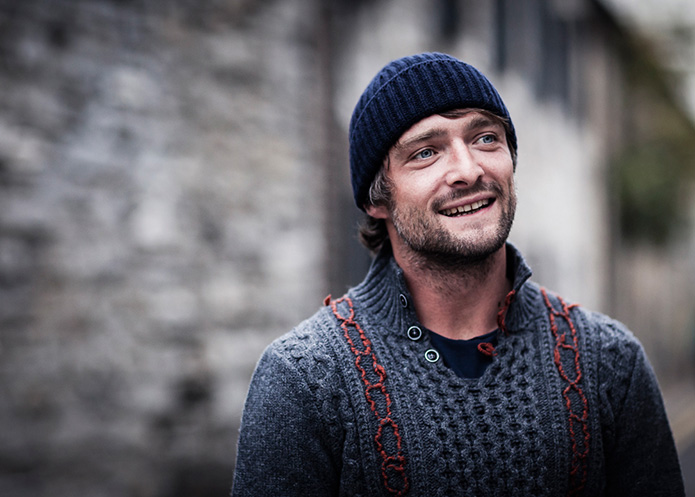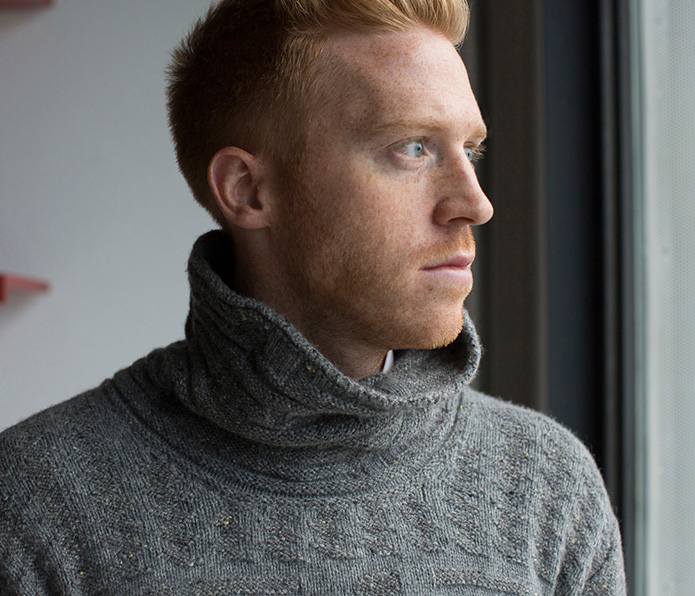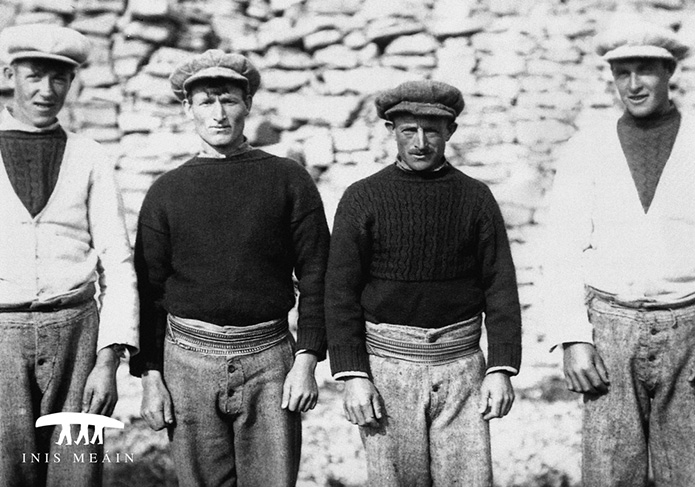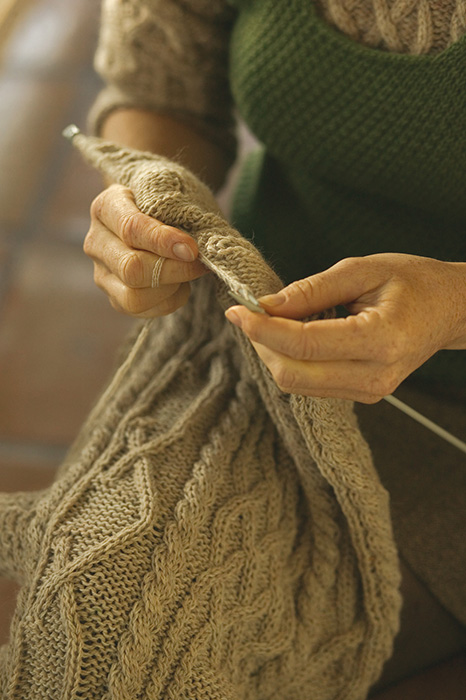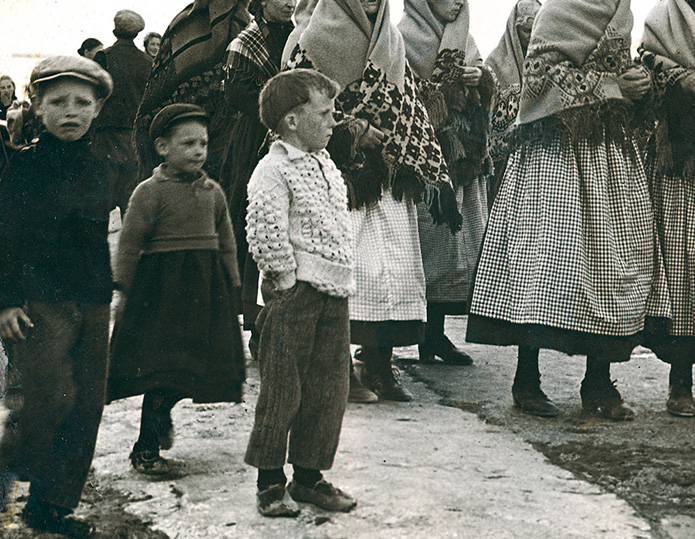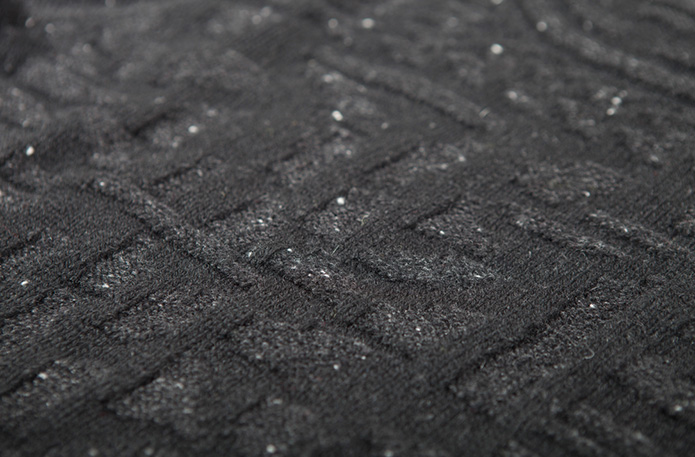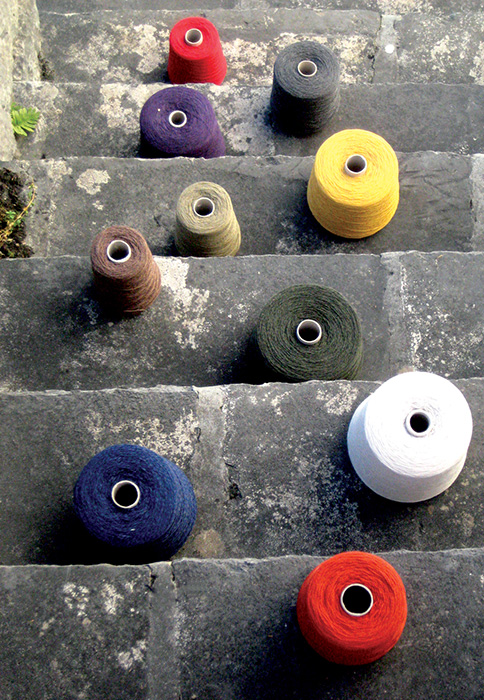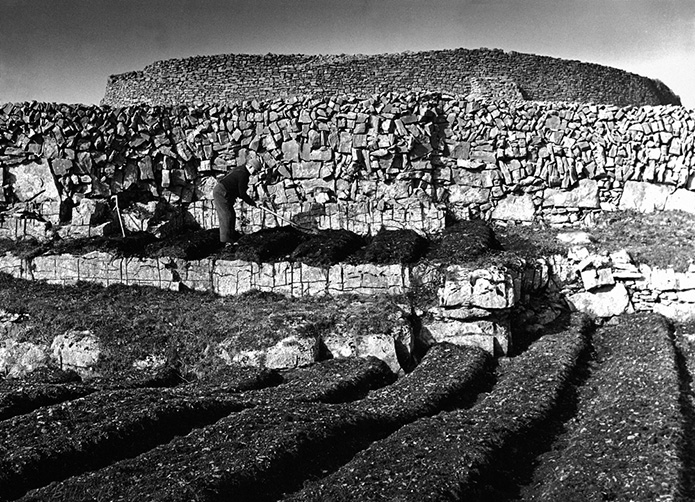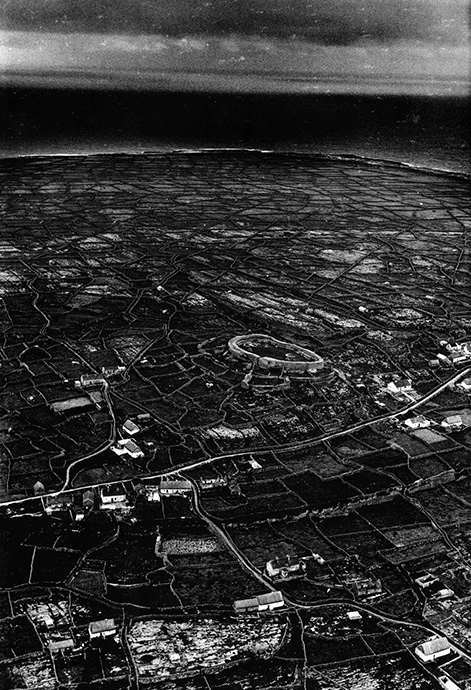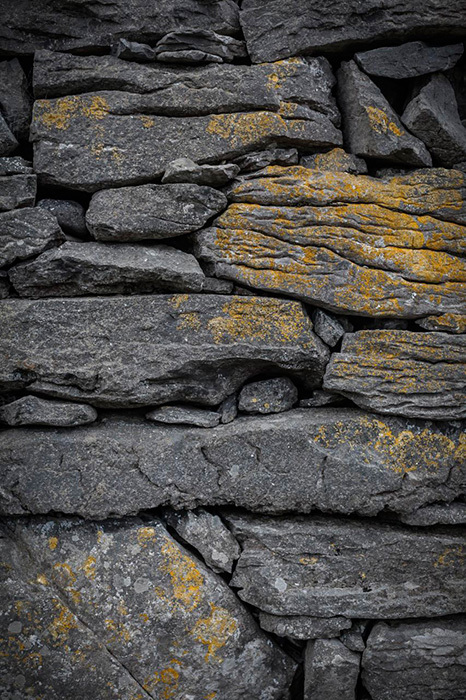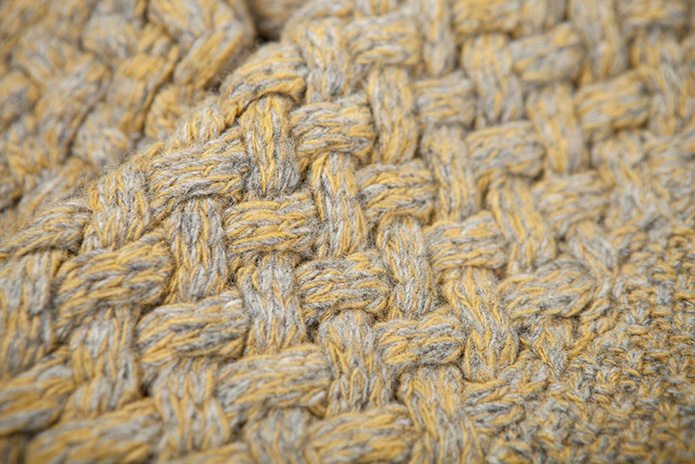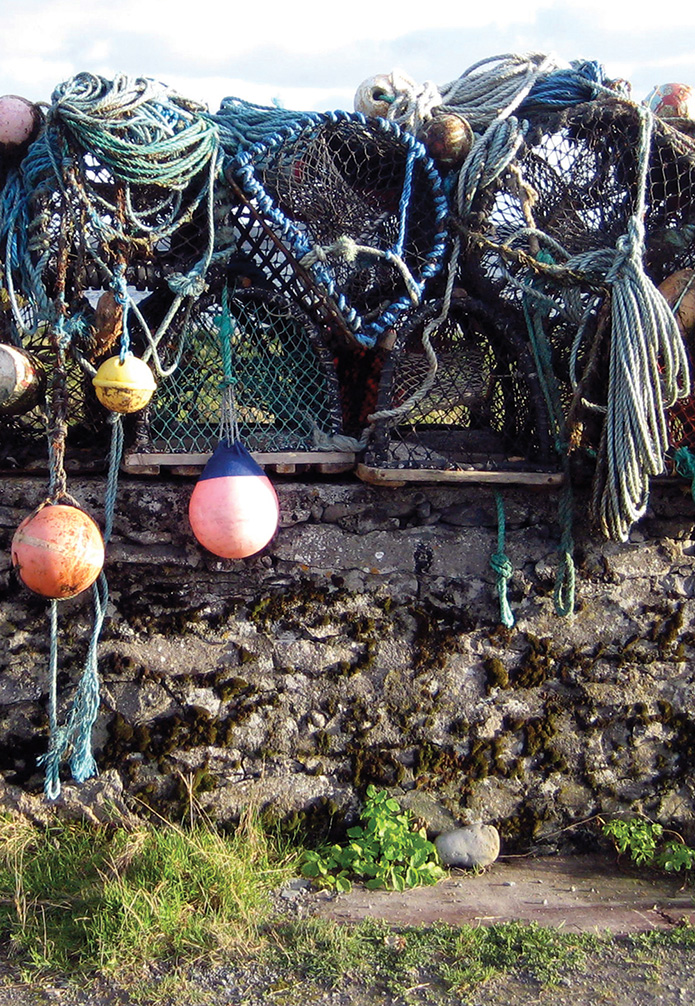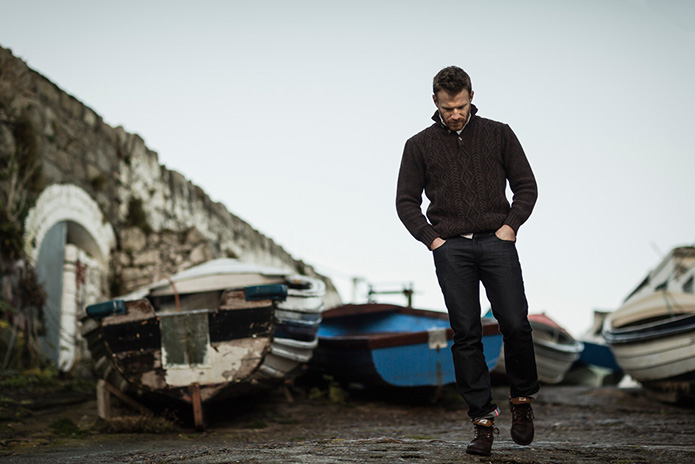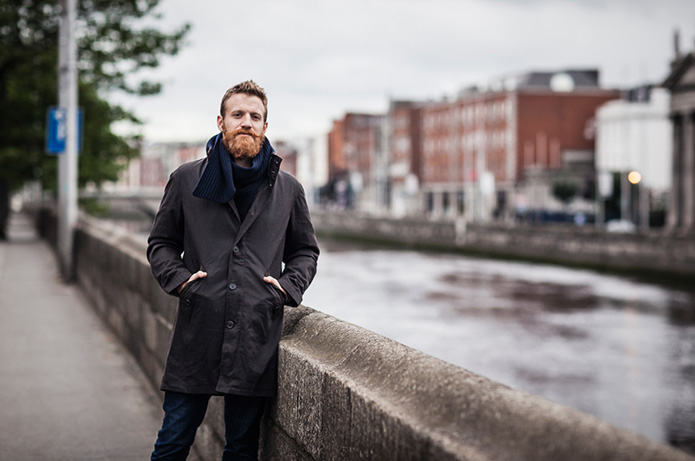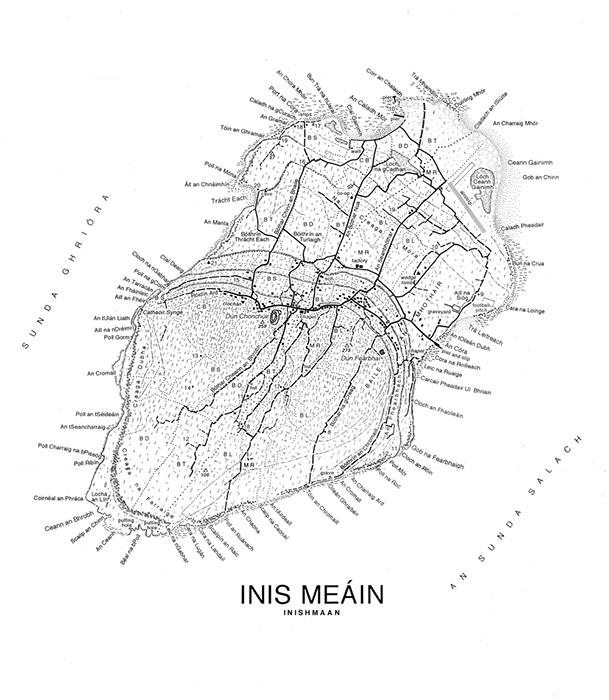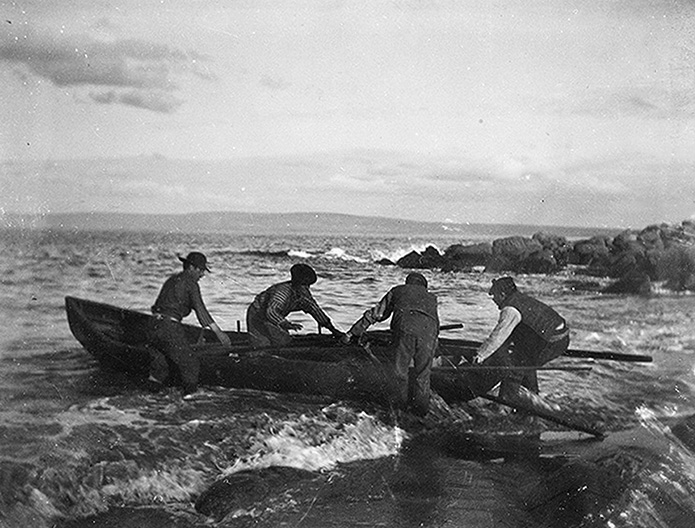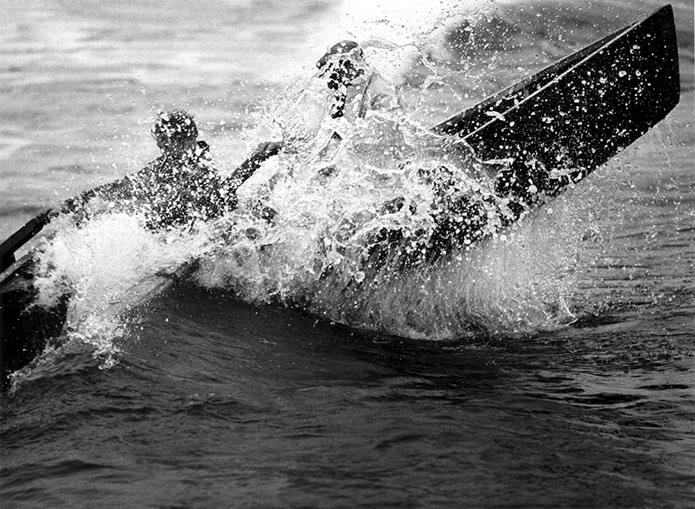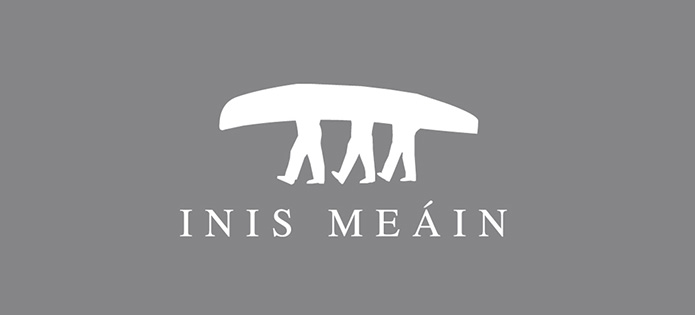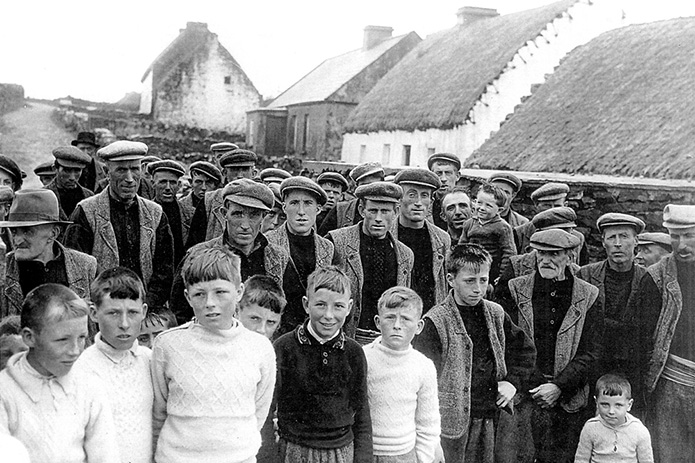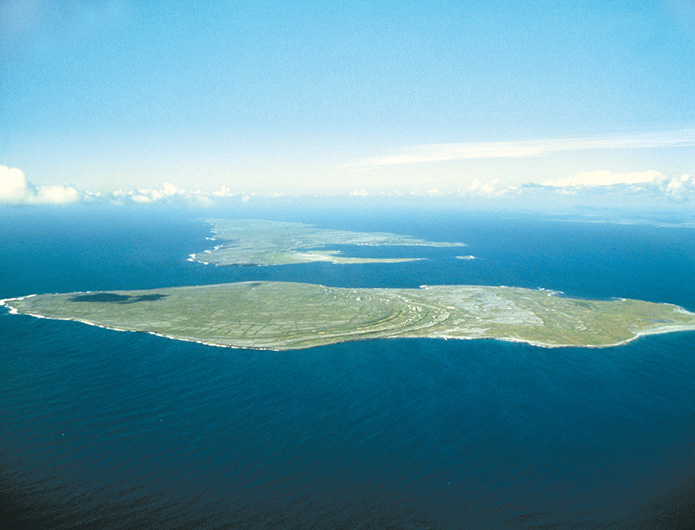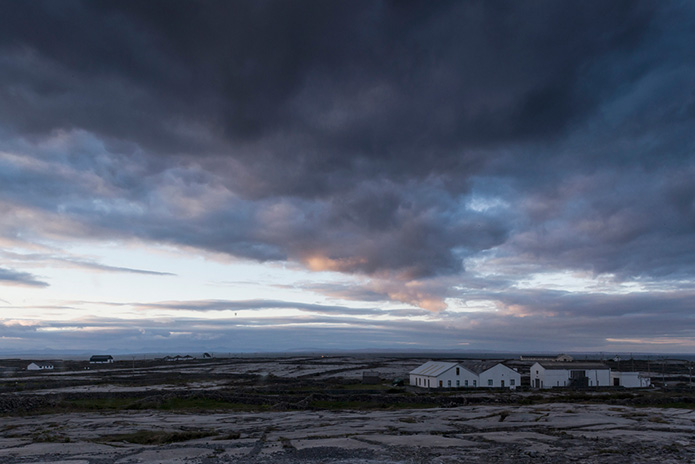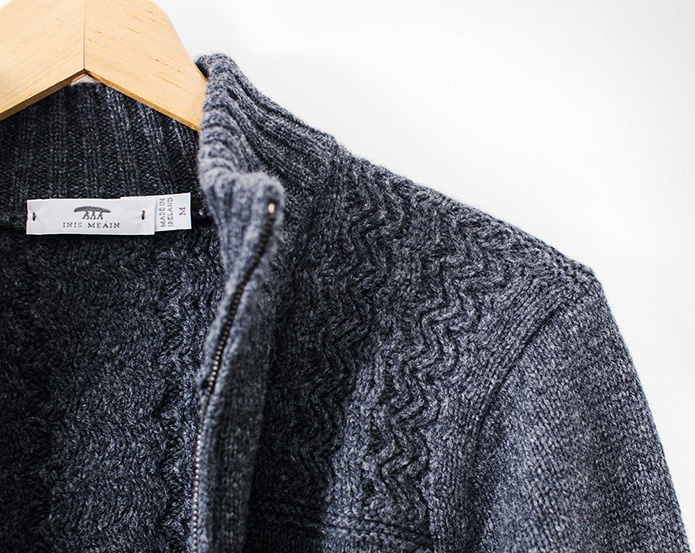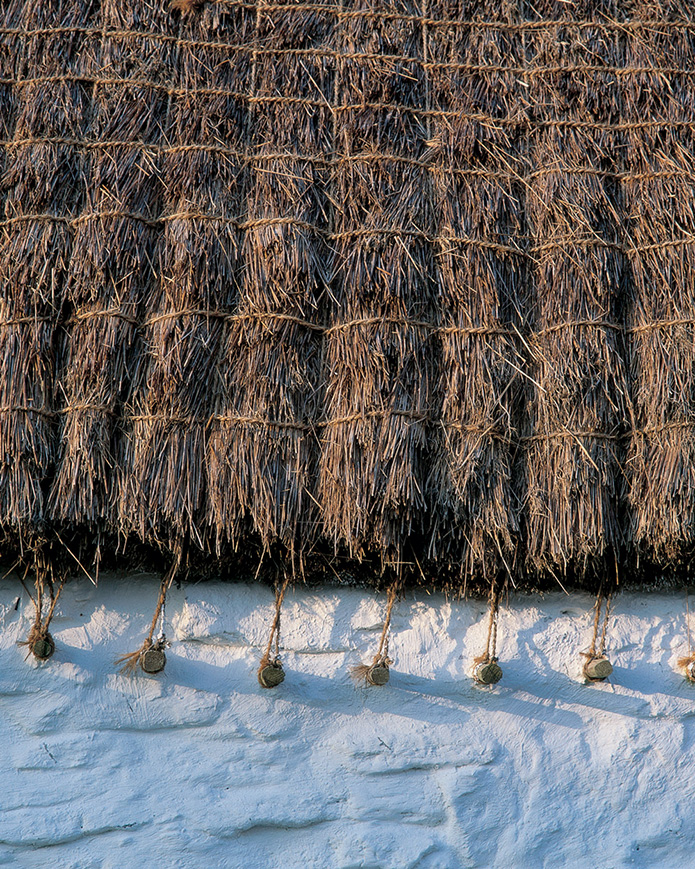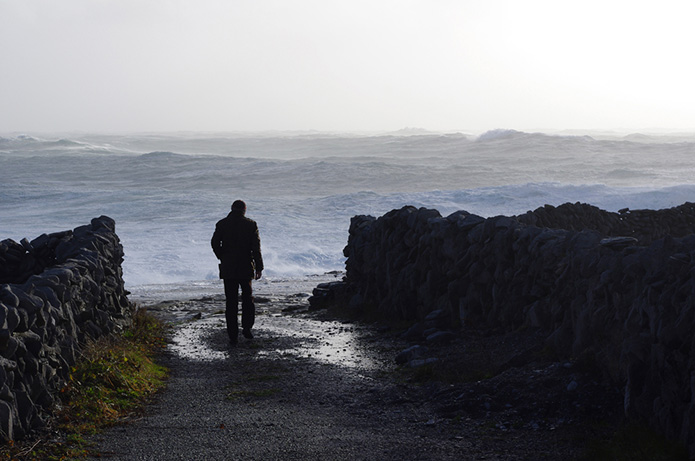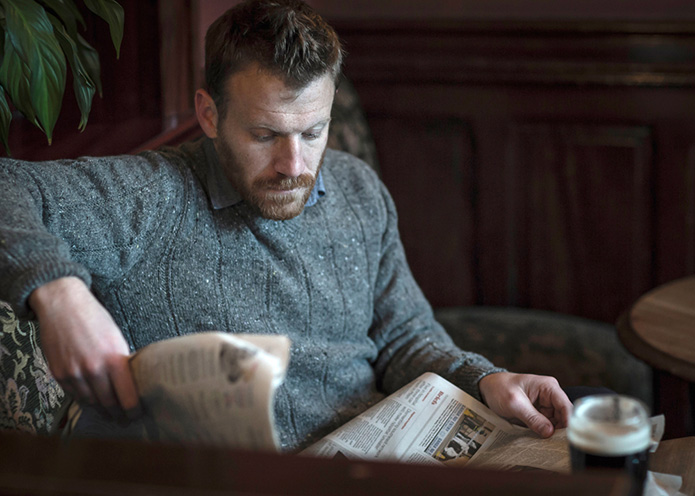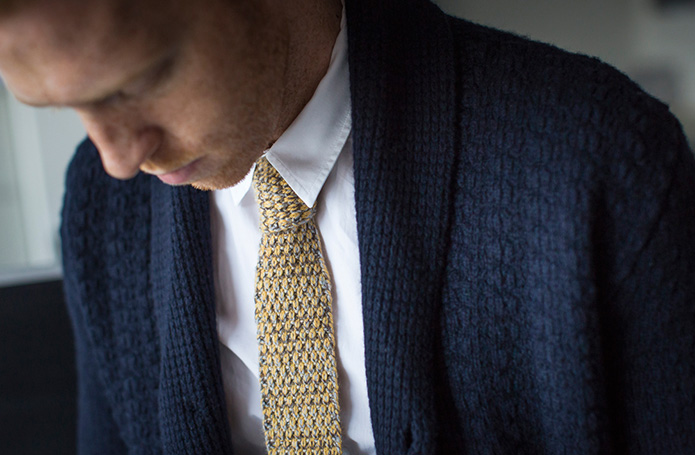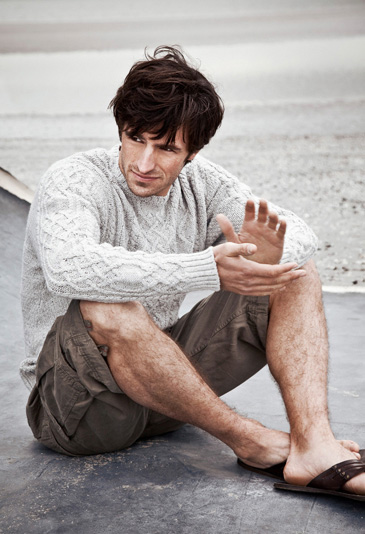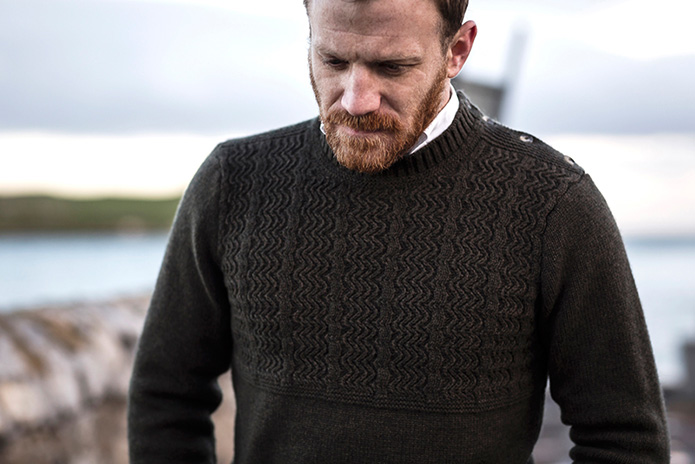
Soft Gaelic syllables, pronounced ‘innish maan’, adds to the almost fabled identity of Inis Meáin as one of the three last stepping stones out of Europe, into the wild Atlantic and beyond; and it is the remote raw beauty of this, Aran’s middle island, that has bred a culture as strong as the age-old limestone on which this unique island community clings to, and yet also thrives upon. It is the inherent stoic self-sufficiency borne out of fishing the often angry waters of the North Atlantic that has created a small island company of global recognition – Inis Meáin Knitting Company.
For centuries Inis Meáin fishermen have braved the tempestuous waters, wearing only woollen jumpers as a means of protection against the weather. These practical garments were hand-knitted by the island’s women-folk from the local wools – greys and browns – naturally warm and wind resistant and water-proofed by the sheep’s oily lanolin; a necessity when exposed, miles from the shore, doused in sea-spray at best, drenched in stormy waves at worst. Yet these resilient and restrained jumpers also had a flourish of decoration, often for luck, in attempt to appease the ever-present threat of working the sea, feeding human nature’s innate need for satisfying superstition.
It is this combination of practicality and aesthetics that Tarlach de Blacam, founder of Inis Meáin Knitting Company, has nurtured and evolved. A graduate in Celtic languages from Trinity College originally, Tarlach was drawn to the island and its Gaelic traditions, like so many more academics and artists who had visited before him. However, Tarlach settled there and set about helping to promote and sustain the island’s authenticity as well as its economic viability, by helping evolve the cottage industry of clothing the men-folk and tempting the passing tourists and turning it into a global brand, providing valuable employment as well as an assured continuation of the island’s identity and heritage.
And this is what makes a piece of Inis Meáin knitwear so special. They are pretty much limited edition pieces, in the traditional stitched island style, yet in luxury yarns of alpaca, cashmere and merino wools, coloured by the inspiration of weather-lightened exposed limestone, golden lichen-licked stone walls and soft-hued muted mosses, all contemporary takes on traditional styles that are progressively authentic and have captured the heart of a global high-end market. Every part of an Inis Meáin garment is made to the highest quality, each a modern take on the island’s heritage, down to the trademark label – the simple silhouette of the up-turned currach carried by fishermen – symbolising the island’s age-old tradition of the fishing and the steadfastness of the islanders, who up until very recently still ventured out in such vessels to export the iconic knitwear to the mainland and beyond.
Here Tarlach guides us through what it means to build a traditionally-crafted global brand in a truly tiny and wild part of the world…
Firstly, for those readers who aren’t familiar with Inis Meáin Knitting Company, please can you tell us about the company and style of knitwear?
The company was formed just under 40 years ago on the island of Inis Meáin. I founded the company as part of an Ireland cooperative enterprise aimed at providing employment in the mid-1970s, although the business has evolved a lot since. In the beginning, we made sweaters for tourists and the Irish ethnic market, selling to shops in America, and we were very much dependent on the tourist trade and the strong dollar for sales. This all changed in the late 1970s, triggered by the oil crises at the time, which resulted in a collapse in the value of the dollar and a decline in sales. We realised we needed to change what we were doing and decided to refocus our attentions on exporting and specifically focussing on items at the top end of the market.
At the same time, I became more involved in knitwear production and less on the business administration of running the cooperative. I bought out the equity of the knitwear company from the cooperative and took full ownership, although I did remain as a Board member of the cooperative.
The style of our knitwear has always been influenced by the heritage of island life on Inis Meáin. Our staff at the very beginning were mostly young women, most of whom are still with us today, who had learnt traditional knitting from their mothers, and still had the inherent skills, and we were able to embrace them and develop them further into contemporary adaptations of traditional knitwear.
Can you explain the connection between Inis Meáin, the company, and Inis Meain, the island, with its rich culture and heritage, deeply rooted in the traditional fishing industry?
Employment on Inis Meáin has been dominated by the fishing industry for centuries, with the men-folk going to sea in their currachs, narrow wooden frame canoe-like boats covered in canvas and tar. Families on the island have always been large, and even up to forty years ago, families would often have up to eight-to-ten children, with all the youngsters sharing in work. The girls would learn handknitting to make items of clothing for the men-folk, as well as selling some items to tourists. It’s some of these girls that came to work for us in the beginning.
There’s certainly more to our heritage than the stereotyped Aran fisherman sweater – the highly decorated, almost angelic, white sweater known throughout the world. These weren’t, in fact, fishermen sweaters at all, but were actually the ‘Sunday Best’ sweater worn by children for their First Communion, Confirmation and other special occasions.
The fisherman used far more practical sweaters in darker colours; they used imported indigos, as well as grey and brown wool from local sheep. They were far more restrained, with simple moss-stitch and yolk patterns at the top of the sweater and plain down below and on the sleeve. It is these designs that have more recently influenced Inis Meáin, the company.
Does your knitwear still include the original stitch patterns from the past and do you still use yarns produced from sheep reared on the island?
We take the traditional basic stitch which we knit into our styles. There are a huge range of traditional stitches in our archive that we are continually researching which influences what we create, and we are constantly evolving and trying new ideas and nothing stays static.
It’s no longer possible for us to use wool from local sheep as there aren’t any yarn spinners on the island; in fact there are hardly any yarn spinners left in Ireland either. Instead we began to favour luxury materials as that is what our export customers from the Germany, USA and Japan requested, such as wool and cashmere blends from Italy and wool and silk blends from Peru, which are 80% baby alpaca and 20% silk and feel extra-luxurious. We also use organic pima cotton from Peru, where the supplier has begun reviving old lost colours, as well as Irish linen, and linen from Belgium. We always go for the best available materials.
Are your styles and patterns solely dependent on the traditional Aran fishermen’s sweaters, or do you draw inspiration from other facets of island life and the environment?
We draw inspiration; for example, our 2014 autumn/winter collection is inspired by the stone walls that are commonplace on the island. The Aran Islands are formed on low lying limestone beds, with only a thin layer of soil and not many trees. Islanders have been reclaiming land from rock for thousands of years, and creating small fields surrounded by dry stone walls known as Clai.
These walls protect sheep from the elements, which is something you really notice when you step from the sea shore and crouch behind a wall. The stone walls are amazing to look at from the air and from high points on the islands. The writer, Tim Robinson, who lived here for many years estimates there are over 1,500 miles of walls that have been built by hand on the Aran Islands.
The dark limestone rock that forms the walls are covered in different coloured lichens, from yellows to greys and greens. We created new patterns reflecting the pattern of walling using colours which evoke the landscape. Landscape colours change all the time here on the island; colours changing with the seasons and the light. We have a huge range of things that will continue to inspire us.
Why do you feel Inis Meáin knitwear is still relevant today and has been so well-received, not just in Ireland, but globally?
Worldwide, there has been huge interest in Inis Meáin which has grown significantly in recent years, particularly in Europe, Japan and the USA. I certainly noticed that shortly after the downturn in the world economy there had been a change and a much greater interest in the provenance of fabrics, similar to changes being experienced in the food industry.
From the mid-to-late Noughties, a huge amount of knowledge of weaving, spinning, knitting and yarns has been lost from the UK and Ireland to Eastern Europe, Asia and Africa. I would regularly get approaches from people promising that we could have our production made cheaper elsewhere, but I have always resisted the temptation to go abroad for production as I wanted to stay true to our heritage.
It was certainly tough attracting Irish staff in those boom years and we augmented our workforce by employing Eastern European staff who became available on the island to work for us. I’m pleased we did it this way, and didn’t outsource production, as the wheel has certainly turned full circle; retailers are searching us out such is the renewed interest in provenance of products. We have the story and the heritage which people are interested in, as well as a quality product.
Is there a typical Inis Meáin customer?
I’m not that sure that there’s a typical customer, but we know who we are aiming to sell to, which is the top end of the market, globally. Operating from our remote location, with all the disadvantages of being situated on a small island, we can’t compete on volume, and we have to compete on design, styling and quality, selling our individuality.
Our customers buy into that. We aren’t selling to those people that are purely brand focussed and we offer an alternative to the big brands. Our retailers enjoy telling our story to their customers and people like learning about our heritage. We have customers throughout the world, especially Japan and the USA, but our sales have especially grown in the UK, Scandinavia, Russia and Holland in recent years.
You’re not from the Aran Islands originally. What brought you to Inis Meáin and what was the catalyst for you setting up the knitting company?
The island had changed very little for 100 years when I first came over, from the days when Irish poets, playwrights and other literary figures, such as John Millington Synge, Douglas Hyde and Lady Gregory, stayed here. They came here specifically for its remoteness and inaccessibility and the folk
tradition and rich Gaelic language that was spoken here. That’s what brought me here.
I studied Celtic Languages at Trinity College, Dublin, in the late 1960s / early ‘70s and was sent here to learn the Irish language, Gaelic, and fell in love with the place. I went back to Dublin to conduct research into Irish placenames for the Placenames Commission, at that time part of the Ordnance Survey, where I met my wife, who was from Inis Meáin originally, and we decided to return. When you study Celtic languages you are groomed to continue research into Gaelic, but I knew I didn’t want to become an academic. I was passionate about the Gaelic language and the preservation of our heritage is hugely important to me, but I thought one of the best ways I could help was by getting involved in setting up a co-operative on Inis Meáin, where Gaelic is still the first language, to provide local employment services, helping stem the tide of emigration, as a lot of youngsters would leave for England or the USA, and help develop the community to get electricity, running water and a proper ferry service.
At the time there was no electricity or running water and all supplies were rowed ashore via the currach, which is the way all cargo was brought to-and-from the island. In fact for the first fifteen years that I was here, everything was rowed over, although a small regular air service began around this time as well.
As part of the cooperative, one of the things we did was set up a small knitting workshop which was the formation of the company Inis Meáin. It was hard in those early days, as everything we made had to be rowed to the ferries that were anchored offshore. Whilst we rely on the air service today, because the currach was such an intrinsic part of island life here, we incorporated an upturned currach in our logo, which we have registered as a trademark worldwide, and we incorporate into all our sweaters.
To what extent has the establishment of Inis Meáin achieved one of your original objectives to stem the tide of emigration from the island?
We employ 17 people, which makes us a key employer on the island, but I couldn’t really claim it has been hugely successful in stemming the tide of emigration. There has been a dramatic drop in the size of families on the island, and whereas forty years ago there would have been about 10-15 families on the island each with between 5-8 children, today the average family size has dropped to 2-3 children per family, which is principal reason for the drop in population in recent years.
The decline in the size of the population, and the corresponding drop in school numbers, still poses a threat to the future sustainability of the island. The education authorities recently reduced the number of teachers from two to one, which is a hugely retrograde step, which makes it nigh on impossible to run a school with only one teacher covering a wide range of ages from three to twelve years. We only have a few inhabited offshore islands in Ireland, and I believe the authorities should make a special case for islands such as ours; otherwise it will undoubtedly exacerbate our problems even further.
With such a small number of inhabitants on the island, is there a danger that you will experience skills shortages in time if the company keeps growing at the rate it is? And, related to this, if you need to hire staff from the mainland, could this impact on the unique way of life on the islands with its Gaelic-speaking culture?
The Gaelic speaking culture here, and elsewhere, is under threat due to the media more than anything else. It’s still the first language of the island and it’s encouraging that people that we have hired from the mainland and further afield, such as the Eastern European families I mentioned earlier, have all embraced the language and their children are taught in Gaelic in the local school. However, the future is not assured due to the small family-sizes in recent years and the media, so we can’t be complacent and need to be aware of the issues in order for it to continue to flourish and grow. The population of the island has stabilised, but it’s not growing, which we would like to see. We are hopeful we will see some people move back from the mainland.
Whilst our company has steadily grown, I don’t really see future growth putting a strain on island life, for the principal reason that our growth will come from creating higher value items, using more exclusive and better quality materials such as cashmere, rather than growing through greater volume, so I can’t see a time when we will have to hire huge numbers of staff from the mainland, or move to the mainland to expand production. Since the downturn in the economy from the late Noughties, I sense that people aren’t chasing crazy building projects in Ireland as they were, and there has been more interest in reviving traditional skills, which will help businesses such as ours.
Has the international awareness of your company boosted tourism on the island?
We haven’t really seen a sudden influx of tourists, but then people coming to see us aren’t on bus tours. We tend to have a smaller number of tourists, but they are higher value in what they add to the economy, rather than day-trippers that might just buy a postcard. The tourists who visit here really enhance the economy as they tend to stay for a while.
Does the remoteness of Inis Meáin cause logistical problems, particularly during the rough and stormy Atlantic winter season?
Inis Meáin is a very different place in the winter compared to what the tourists see in the summer and the weather does cause us problems. Last winter, for example, was a nightmare, and the worst I can ever remember. Normally you get breaks in the weather, but this time it was relentless, with mountainous seas and huge swells making it very difficult to travel by ferry and the air service; the latter finding it very difficult with the strong cross winds and poor visibility.
Weather considerations do make you plan logistically when you know you have goods to ship regularly, so you plan ahead, and do trips once week or once fortnight, rather than thinking you can do it daily.
We are very dependent on our air service, which we struggled to maintain, but we fought a battle with the Government agency subsidising it and succeeded in holding onto the service, which is very important to us.
With a range of over fifty designs, how do you intend extending the range, and from where will you draw inspiration?
We will certainly be extending the range, and I would get bored stiff if we were doing the same thing each year. I really enjoy trying new things out and working with different yarns, colours, style and patterns. We have a wealth of ideas to draw from on the island, so we will never struggle for lack of inspiration.
What’s next for Inis Meáin; are we going to see greater ranges, wider use of materials, collaborations with other designers, for instance?
We will be continuing with a similar size of range for the foreseeable future, but varying it and adding new spice to the mix. We already have an extensive archive for new knits and styles for every season.
We will move into new materials; yarn sourcing is a really important part of the design process for us, and the introduction of organic cotton was a big success, and so too mixing it with linen, and we will continue to look at new yarns.
As for collaborations, we have already collaborated with other designers, such as Yohji Yamamoto, where we did three styles with them. We are often approached by designers to collaborate with them; sometimes it works, and sometimes it doesn’t, as we can’t re-invent our collection for someone else. We do a lot of work with the University of Ulster, which is very well geared up for training youngsters in knitwear. We invite interns to come and stay with us for a while, and they participate in design meetings where they have the opportunity to contribute to new collections. We’re a good place for them, as unlike many other companies, we do everything under one roof, such as design, market development, marketing, sales and production. We enjoy working with interns as they are a constant source of fresh ideas and like to question how we do things.
We have been growing steadily in recent years, and whilst we are ambitious and want to continue to grow, this will be growing via an emphasis on higher value, rather than volume. We are not looking for dramatic growth, as that would bring its own set of problems, but rather steady, sustainable growth.
Thanks to Tarlach de Blacam for taking time out of his busy schedule to answer our questions. All images © Inis Meáin Knitting Company.

